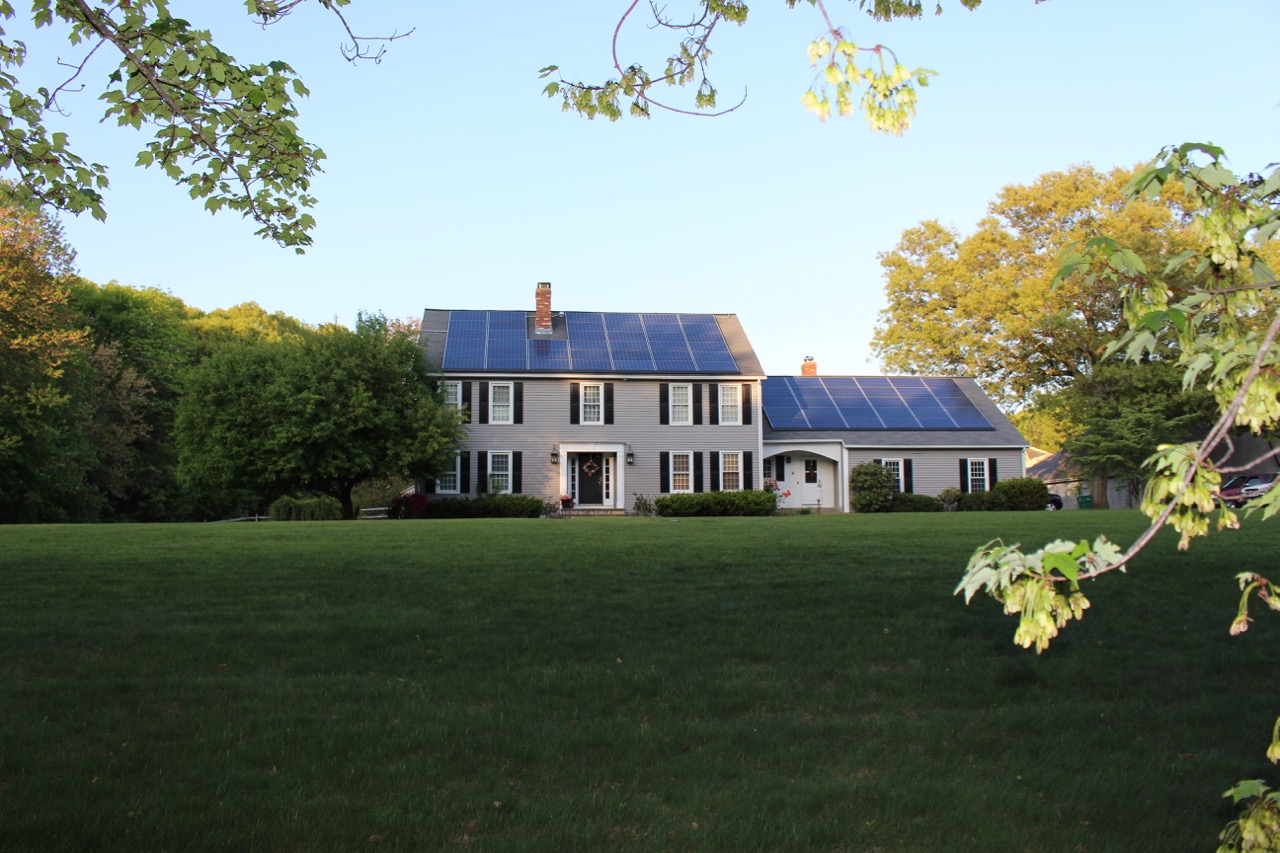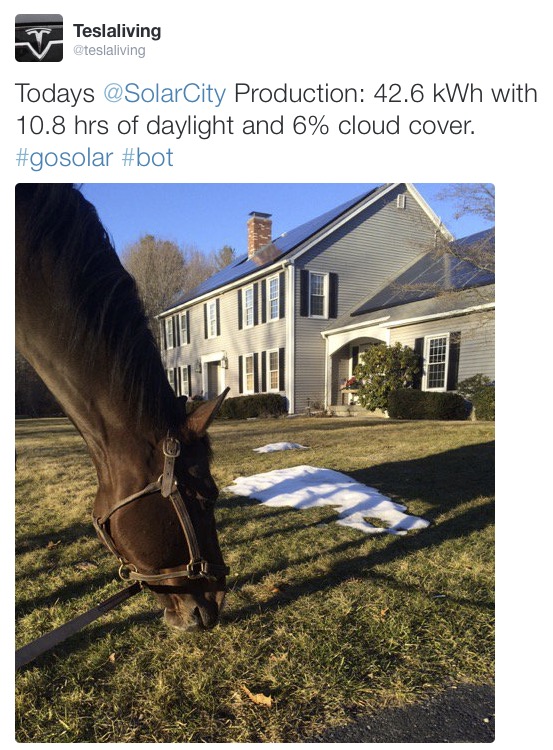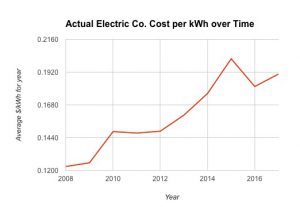News
Report: Solar savings through a SolarCity residential system

Having limited winter daylight hours combined with snow covered rooftops doesn’t make for good check out my huge solar savings conversation this month. But putting that aside, the overall economics behind my solar system tells a far greater story.
If you’ve been following along, you’ll recall that my journey with installing a SolarCity system dates back to late 2014. My system consists of 69 panels at 255W each for a total of 17.6kW (more specs on the system can be found on my Solar Generation page).
Solar Pricing
Massachusetts Electricity prices having been rising at approximately 9.5% year-over-year since 2008. When I started with SolarCity, my electricity price was set at $0.1627 per kWh including delivery, supply and taxes. Prices have continued to climb as seen on this chart.
The state went through a fun over-inflation and correction period in 2015, but the current rate I’m paying for electric is $0.1906 kWh with the best supplier I can find.
SolarCity sets their Power Purchase Agreement (PPA) prices based on your current electricity usage and comparable rates for the area that’s receiving their solar system. I had a number of options when I signed up including a variable rate, a fixed rate and an outright purchase but ended up opting for a 20-year fixed rate plan at $0.1420 kWh.
The way the PPA plan works is that I pay $0.1420 for every kWh generated by the SolarCity panels. The kWh they generate offsets the electricity I would consume. My savings initially worked out to be a difference of $0.0207 kWh or approximately 13% less. Recent savings have been in the $0.0486 kWh mark, or 25%, helped by the rise in electricity rates from utilities.
I incurred no installation or service costs when first setting up my SolarCity system, hence my entire cost for set up is based on the amount of power generated at $0.1420 kWh.
Affiliate: Get a solar cost estimate and find out how much solar can save for your home and business in your area.
Solar Costs
In the last 22 months, I’ve generated a whopping 33.8 MWh (33,800 kWh) of power. My cost for that was $4,800. The SolarCity bill will fluctuate depending on the amount of daylight hour and weather conditions.
In that same period, my electric company reported that I used 23,800 kWh of power. Since the solar power offsets that amount, my actual power use for those 22 months was 57,600 kWh — I use a lot of power between my Tesla, pool, A/C and other electronics we have throughout the house.

Follow @Teslaliving
About 59% of the power I need for my house and my Tesla comes from my SolarCity system. I wanted a system that could cover 100% of my needs but National Grid (local electric company) blocked that.
For the 23,800 kWh I purchased from the electric company, I paid $4,595, or $0.1930 kWh (averaged over the 22 months). My total electric cost (money paid to electric company and to SolarCity) for the 22 months was $9,395 or about $427/month.
While I consume a lot of power, 59% of it is provided by the sun.
Solar Savings
When I first signed up with SolarCity, they provided a $1,000 bonus if you registered for a solar system after buying a Tesla. That’s what I did and that’s how I received my $1,000 check form SolarCity.
They also had a referral program at the time which credited you with $250 for each person that signed up for a new system. I managed to get one referral and one more check from SolarCity.
All in all, I started 22 months ago with no money down and $1,250 in my pocket and a nice new solar system on my house. Not a bad start!
Had I purchased all my power from my electricity company at the average of $0.1930 kWh it would have cost me a total of $11,117. But thanks to SolarCity, my total cost was $9,395, so my savings was $1,722 over the 22 months. I expect savings and solar benefits will continue to grow over the next 20 years as the electric company continues to raise their rates.
SolarCity doesn’t fully capture the amount of savings that can be had through their system since the initial quote is based on current electricity rates, at the time of the quote. Rates climb over time especially in dense urban areas.
My savings thus far has been more than twice the amount SolarCity originally outlined! Now, if we add in the referral checks, my savings goes up to $2,972. The referrals don’t necessarily scale over time and may get updated so that needs to be factored into the equation.
Summary
For no money down and no risk, I’ve saved about $3,000 in just under 2 years (27% of what I would have paid) while generating green energy and taking load away from an already overloaded power grid.
When I did the math before signing up I knew the system would be a good deal and I’m very happy to see the results proving out. Since I’m on the power purchase program, I don’t have to worry about equipment depreciation, loss in solar cell effectiveness over time (I only pay for what they generate) or a whole slew of other things. By the time my plan is up, much better systems will be available.
If you’re interested in exploring solar power for your house and have enjoyed my posts thus far, please consider using my referral link to get started. SolarCity will do a free analysis of your situation and let you know if a solar system may work for you: share.solarcity.com/teslaliving
May the Sun be with you!

Elon Musk
Starlink passes 9 million active customers just weeks after hitting 8 million
The milestone highlights the accelerating growth of Starlink, which has now been adding over 20,000 new users per day.

SpaceX’s Starlink satellite internet service has continued its rapid global expansion, surpassing 9 million active customers just weeks after crossing the 8 million mark.
The milestone highlights the accelerating growth of Starlink, which has now been adding over 20,000 new users per day.
9 million customers
In a post on X, SpaceX stated that Starlink now serves over 9 million active users across 155 countries, territories, and markets. The company reached 8 million customers in early November, meaning it added roughly 1 million subscribers in under seven weeks, or about 21,275 new users on average per day.
“Starlink is connecting more than 9M active customers with high-speed internet across 155 countries, territories, and many other markets,” Starlink wrote in a post on its official X account. SpaceX President Gwynne Shotwell also celebrated the milestone on X. “A huge thank you to all of our customers and congrats to the Starlink team for such an incredible product,” she wrote.
That growth rate reflects both rising demand for broadband in underserved regions and Starlink’s expanding satellite constellation, which now includes more than 9,000 low-Earth-orbit satellites designed to deliver high-speed, low-latency internet worldwide.
Starlink’s momentum
Starlink’s momentum has been building up. SpaceX reported 4.6 million Starlink customers in December 2024, followed by 7 million by August 2025, and 8 million customers in November. Independent data also suggests Starlink usage is rising sharply, with Cloudflare reporting that global web traffic from Starlink users more than doubled in 2025, as noted in an Insider report.
Starlink’s momentum is increasingly tied to SpaceX’s broader financial outlook. Elon Musk has said the satellite network is “by far” the company’s largest revenue driver, and reports suggest SpaceX may be positioning itself for an initial public offering as soon as next year, with valuations estimated as high as $1.5 trillion. Musk has also suggested in the past that Starlink could have its own IPO in the future.
News
NVIDIA Director of Robotics: Tesla FSD v14 is the first AI to pass the “Physical Turing Test”
After testing FSD v14, Fan stated that his experience with FSD felt magical at first, but it soon started to feel like a routine.

NVIDIA Director of Robotics Jim Fan has praised Tesla’s Full Self-Driving (Supervised) v14 as the first AI to pass what he described as a “Physical Turing Test.”
After testing FSD v14, Fan stated that his experience with FSD felt magical at first, but it soon started to feel like a routine. And just like smartphones today, removing it now would “actively hurt.”
Jim Fan’s hands-on FSD v14 impressions
Fan, a leading researcher in embodied AI who is currently solving Physical AI at NVIDIA and spearheading the company’s Project GR00T initiative, noted that he actually was late to the Tesla game. He was, however, one of the first to try out FSD v14.
“I was very late to own a Tesla but among the earliest to try out FSD v14. It’s perhaps the first time I experience an AI that passes the Physical Turing Test: after a long day at work, you press a button, lay back, and couldn’t tell if a neural net or a human drove you home,” Fan wrote in a post on X.
Fan added: “Despite knowing exactly how robot learning works, I still find it magical watching the steering wheel turn by itself. First it feels surreal, next it becomes routine. Then, like the smartphone, taking it away actively hurts. This is how humanity gets rewired and glued to god-like technologies.”
The Physical Turing Test
The original Turing Test was conceived by Alan Turing in 1950, and it was aimed at determining if a machine could exhibit behavior that is equivalent to or indistinguishable from a human. By focusing on text-based conversations, the original Turing Test set a high bar for natural language processing and machine learning.
This test has been passed by today’s large language models. However, the capability to converse in a humanlike manner is a completely different challenge from performing real-world problem-solving or physical interactions. Thus, Fan introduced the Physical Turing Test, which challenges AI systems to demonstrate intelligence through physical actions.
Based on Fan’s comments, Tesla has demonstrated these intelligent physical actions with FSD v14. Elon Musk agreed with the NVIDIA executive, stating in a post on X that with FSD v14, “you can sense the sentience maturing.” Musk also praised Tesla AI, calling it the best “real-world AI” today.
News
Tesla AI team burns the Christmas midnight oil by releasing FSD v14.2.2.1
The update was released just a day after FSD v14.2.2 started rolling out to customers.

Tesla is burning the midnight oil this Christmas, with the Tesla AI team quietly rolling out Full Self-Driving (Supervised) v14.2.2.1 just a day after FSD v14.2.2 started rolling out to customers.
Tesla owner shares insights on FSD v14.2.2.1
Longtime Tesla owner and FSD tester @BLKMDL3 shared some insights following several drives with FSD v14.2.2.1 in rainy Los Angeles conditions with standing water and faded lane lines. He reported zero steering hesitation or stutter, confident lane changes, and maneuvers executed with precision that evoked the performance of Tesla’s driverless Robotaxis in Austin.
Parking performance impressed, with most spots nailed perfectly, including tight, sharp turns, in single attempts without shaky steering. One minor offset happened only due to another vehicle that was parked over the line, which FSD accommodated by a few extra inches. In rain that typically erases road markings, FSD visualized lanes and turn lines better than humans, positioning itself flawlessly when entering new streets as well.
“Took it up a dark, wet, and twisty canyon road up and down the hill tonight and it went very well as to be expected. Stayed centered in the lane, kept speed well and gives a confidence inspiring steering feel where it handles these curvy roads better than the majority of human drivers,” the Tesla owner wrote in a post on X.
Tesla’s FSD v14.2.2 update
Just a day before FSD v14.2.2.1’s release, Tesla rolled out FSD v14.2.2, which was focused on smoother real-world performance, better obstacle awareness, and precise end-of-trip routing. According to the update’s release notes, FSD v14.2.2 upgrades the vision encoder neural network with higher resolution features, enhancing detection of emergency vehicles, road obstacles, and human gestures.
New Arrival Options also allowed users to select preferred drop-off styles, such as Parking Lot, Street, Driveway, Parking Garage, or Curbside, with the navigation pin automatically adjusting to the ideal spot. Other refinements include pulling over for emergency vehicles, real-time vision-based detours for blocked roads, improved gate and debris handling, and Speed Profiles for customized driving styles.









